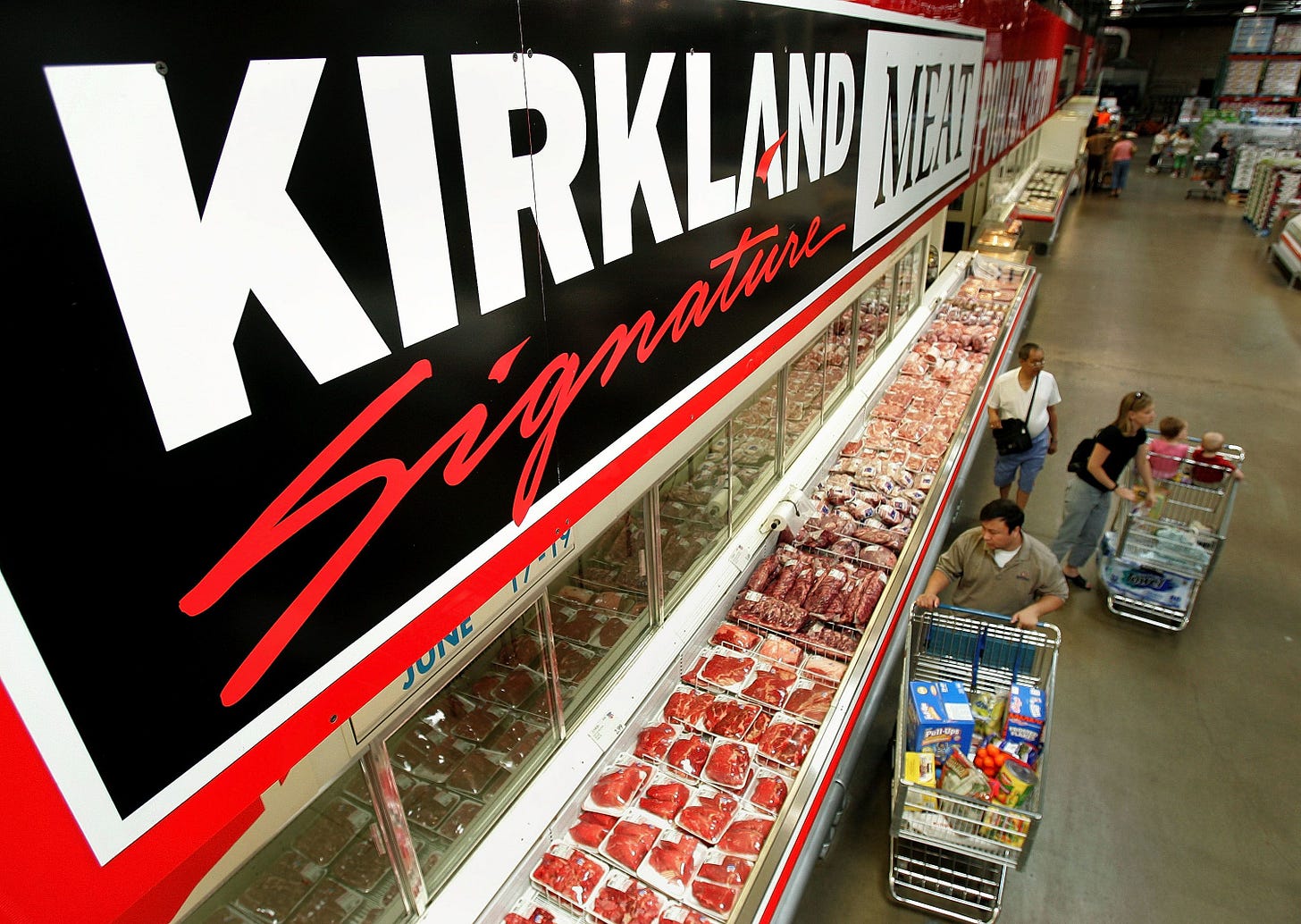Research: Can Kirkland End the Chronic Disease Epidemic?
Integrating Food, Health, and Retail for Better Nutrition
We need to fix food to reduce the healthcare costs of poor nutrition. To do this, we need to consider business systems, supply chains, and service offerings to shift from low-cost calories to affordable nutrition.
I’ve been thinking a lot about retail. Is grocery retail really in the nutrition business? Which then leads me to which grocery would be best? Trader Joes is unbelievable at product management but limited in scale. HEB is skilled at nutrition, but mostly a Texas market.
Perhaps it is not exactly a grocery store; perhaps it is more of a brand. Or a brand within a grocery with the power to affect supply chain.
This leads me to Kirkland.
How might we leverage Costco’s Kirkland brand as a platform to promote better nutrition and align it with emerging obesity solutions (like GLP-1)?
This concept is still half-baked—there’s no polished pitch deck or bulletproof business plan—so I’m sharing it here to spark conversation.
1. Costco’s Core Advantage: Trust, Scale, and Value
Consumer Trust in Kirkland
Kirkland is revered for high quality at competitive prices—this brand equity can be extended into nutrition. Consumers already see Kirkland items as “smarter” or “healthier” choices versus generic store brands.Efficiency & Scale
Costco excels at streamlining supply chains (as with poultry, produce, and even private-label wines). Applying those same efficiencies to “food as health” would quickly differentiate Costco in the market.Middle America Reach
Costco’s membership spans suburban families to small business owners—the very demographic contending with obesity and chronic disease. Putting better nutrition front and center supports a large, loyal customer base.
2. The Healthcare Moment: GLP-1 & Nutrition
Pharma Needs a Partner
Pharmaceutical leaders like Novo Nordisk and Lilly are seeking nutrition partners to create a holistic obesity solution. They know patients need healthy diets alongside GLP-1 drugs for sustainable weight management.Prevent Abuse & Maintain Long-Term Outcomes
If patients use GLP-1 (Ozempic, Wegovy, Mounjaro, etc.) in isolation—and then drop off—they can rebound to obesity quickly. Nutrition-based lifestyle changes will keep people healthier, longer. Pharma wins by building a stable, long-term patient base.Costco’s Opportunity
No retailer has stepped up to own “nutrition + medication” as a combined offering. Costco could be the first—and the most credible—by leveraging its existing pharmacy, trusted brand, and proven logistic prowess.
3. Vertical Integration & Membership Model
Lessons From the $4.99 Rotisserie Chicken
Costco’s in-house poultry complex proved vertical integration can cut costs while delivering consistent quality. The same model can apply to nutrient-rich produce, responsibly raised meat, and functional packaged foods (e.g., high-fiber, low-sugar, probiotic-friendly).Membership Incentives for Healthy Buying
Costco can integrate targeted health programs—like curated “GLP-1 friendly” meal bundles or nutritional subscriptions—into the membership experience. Exclusive deals or in-store education can nudge shoppers toward healthier baskets, increasing both spend and loyalty.Data & Personalization
Using purchase data (via membership IDs), Costco can personalize recommendations on receipts or via the Costco app—offering, for example, a discount on fiber-rich Kirkland products or meal-kits for someone on a weight-management journey.
4. Brand Evolution: From Bulk Retail to Health Ally
A Market Shift Already Underway
Consumers are more motivated than ever to address obesity and chronic disease—especially with the explosion of GLP-1 awareness. If Costco moves quickly, it can set the standard for “retail as healthcare partner.”Defend & Grow Membership
Differentiating on health can lock in existing members and attract new ones who see Costco as a proactive solution for better living—not just bulk savings.Scaling Good Food Affordably
Good nutrition is often seen as expensive or niche. Costco has unique power to bring down per-unit costs and democratize access to healthier foods—even in regions lacking other fresh or affordable options.
5. Proposed Next Steps
Strategic Collaboration with Pharma
Begin a pilot program with Novo or Lilly—bundling nutritional counseling, GLP-1 medications, and specially curated Kirkland products for improved outcomes.Kirkland Health Line Expansion
Develop (or co-pack) new Kirkland-brand functional foods: low-glycemic, higher-fiber, and fermented product lines that align with “Food is Health.”In-Store & Online Integration
Leverage Costco’s pharmacy, in-store signage, and the Costco app to educate on portion control, label reading, and bundling healthy staples (produce, lean meats, dairy alternatives).Membership Engagement
Offer health-focused membership perks—access to a nutrition hotline, discounts on curated health product bundles, or a monthly “Costco Health” newsletter.
Why This Matters for Costco
Future-Proof the Business: As consumer health trends accelerate, retailers who lead on affordable, healthy options will gain market share—and protect themselves against disruptive newcomers.
Enhance Brand Equity: Kirkland stands for quality and value. Adding a “health halo” builds even stronger loyalty and opens new revenue streams.
Social Impact & Differentiation: Addressing obesity and chronic disease directly is a powerful way to demonstrate corporate responsibility and leadership.
By seizing the “food is health” mandate, Costco can do what it does best: use its scale, membership loyalty, and private-label excellence to drive massive shifts in how Americans eat—while reinforcing Costco’s unique position as a retailer that genuinely cares about its customers’ well-being.
Keep reading with a 7-day free trial
Subscribe to Food is Health to keep reading this post and get 7 days of free access to the full post archives.





